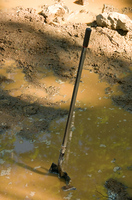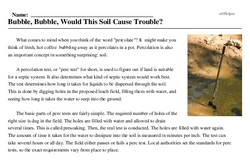Bubble, Bubble, Would This Soil Cause Trouble?
What comes to mind when you think of the word "percolate"? It might make you think of fresh, hot coffee bubbling away as it percolates in a pot. Percolation is also an important concept in something surprising: soil.
A percolation test, or "perc test" for short, is used to figure out if land is suitable for a septic system. It also determines what kind of septic system would work best. The test determines how long it takes for liquids to be dispersed through the soil. This is done by digging holes in the proposed leach field, filling them with water, and seeing how long it takes the water to seep into the ground.
The basic parts of perc tests are fairly simple. The required number of holes of the right size is dug in the field. The holes are filled with water and allowed to drain several times. This is called presoaking. Then, the real test is conducted. The holes are filled with water again. The amount of time it takes for the water to dissipate into the soil is measured in minutes per inch. The test can take several hours or all day. The field either passes or fails a perc test. Local authorities set the standards for perc tests, so the exact requirements vary from place to place.




